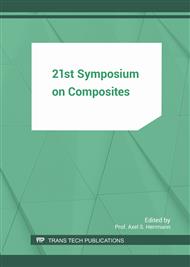[1]
R. B. Heslehurst, Desing and Analysis of Structural Joints with Composite Materials, DEStech Publications, Pennsylvania (2013).
Google Scholar
[2]
H. Wilmes, A.S. Herrmann, B. Kolesnikov, I. Kröber, Festigkeitsanalysen von Bolzenverbindungen für CFK-Bauteile mit dem Ziel der Erstellung von Dimensionierungsrichtlinien, DLR-Jahrestagung (1999).
Google Scholar
[3]
H. C. Hufenbach, M. Gude, J. Troschitz, R. Kupfer, Fügesysteme für Faserverbundstrukturen mit Thermoplastmatrix, Lightweight design (3/2014).
DOI: 10.1365/s35725-014-0371-4
Google Scholar
[4]
J. Schäfer, T. Martens, T. Gries, Konzeptentwicklung für die Integration von Krafteinleitungselementen, Lightweight design (3/2015).
DOI: 10.1007/s35725-015-0007-3
Google Scholar
[5]
K. Giesche, T. Hübner, H. Orawetz, Application of the tailored fibre placement (TFP) process for local reinforcement on an open-hole, tension plate form carbon/epoxy laminates, Composites Science and Technology 63 (2003), pp.81-88.
DOI: 10.1016/s0266-3538(02)00178-1
Google Scholar
[6]
H. Schürmann, Konstruieren mit Faser-Kunststoff-Verbunden, Springer Verlag, Berlin, (2007).
DOI: 10.1007/978-3-540-72190-1
Google Scholar
[7]
T. Botzkowski, S. Galkin, S. Wagner, S. P. Sikora, L. Kärger, Experimental and numerical analysis of bolt-loaded open-hole laminates reinforced by winded carbon rovings, Composite Structures 141 (2016), pp.194-202.
DOI: 10.1016/j.compstruct.2016.01.057
Google Scholar
[8]
E. Witten, T. Kraus, M. Kühnel, Composite Market Report - Market developments, trends, outlook and challenges, Study by AVK and Carbon Composites (2016).
Google Scholar
[9]
CVC-News, Kompetenz aus einer Hand, Unternehmensvorstellung Weberit Werke Dräbing, (1/2013).
Google Scholar
[10]
Exhibition show of Krauss Maffei, K-Messe, Düsseldorf, (2016).
Google Scholar
[11]
T. Huber, Einfluss lokaler Endlosfaserverstärkungen auf das Eigenschaftsprofil struktureller Spritzgießbauteile, Dissertation, Frauenhofer Verlag, Stuttgart, (2014).
Google Scholar
[12]
K. Arnaut, P. Schiebel, A. Lang, A. Herrmann, Reinforcement elements aligned with the direction of forces for load transfer areas of long fiber reinforced thermoplastic components, 20th Symposium on Composites, Material Science Forum Vols. 825-826 (2015).
DOI: 10.4028/www.scientific.net/msf.825-826.779
Google Scholar
[13]
DIN 65562: 1991-05 (D), Luft und Raumfahrt, Faserverstärkte Kunststoffe, Prüfung von multidirektionalen Laminaten, Bestimmung der Lochleibungsfestigkeit.
DOI: 10.31030/2613854
Google Scholar


